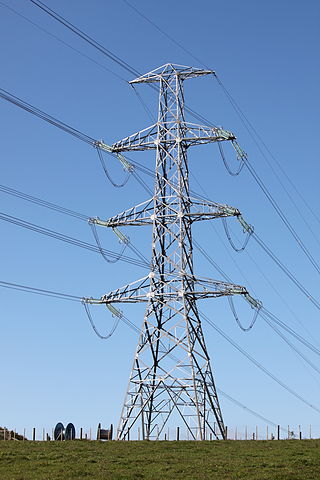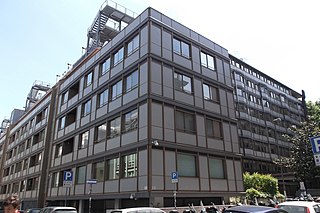
Electric power transmission is the bulk movement of electrical energy from a generating site, such as a power plant, to an electrical substation. The interconnected lines that facilitate this movement form a transmission network. This is distinct from the local wiring between high-voltage substations and customers, which is typically referred to as electric power distribution. The combined transmission and distribution network is part of electricity delivery, known as the electrical grid.

Electric power distribution is the final stage in the delivery of electricity. Electricity is carried from the transmission system to individual consumers. Distribution substations connect to the transmission system and lower the transmission voltage to medium voltage ranging between 2 kV and 33 kV with the use of transformers. Primary distribution lines carry this medium voltage power to distribution transformers located near the customer's premises. Distribution transformers again lower the voltage to the utilization voltage used by lighting, industrial equipment and household appliances. Often several customers are supplied from one transformer through secondary distribution lines. Commercial and residential customers are connected to the secondary distribution lines through service drops. Customers demanding a much larger amount of power may be connected directly to the primary distribution level or the subtransmission level.

Power-line communication, abbreviated as PLC, carries data on a conductor that is also used simultaneously for AC electric power transmission or electric power distribution to consumers.

The electric power industry covers the generation, transmission, distribution and sale of electric power to the general public and industry. The commodity sold is actually energy, not power, e.g. consumers pay for kilowatt-hours, power multiplied by time, which is energy. The commercial distribution of electricity started in 1882 when electricity was produced for electric lighting. In the 1880s and 1890s, growing economic and safety concerns lead to the regulation of the industry. What was once an expensive novelty limited to the most densely populated areas, reliable and economical electric power has become an essential aspect for normal operation of all elements of developed economies.

A substation is a part of an electrical generation, transmission, and distribution system. Substations transform voltage from high to low, or the reverse, or perform any of several other important functions. Between the generating station and consumer, electric power may flow through several substations at different voltage levels. A substation may include transformers to change voltage levels between high transmission voltages and lower distribution voltages, or at the interconnection of two different transmission voltages. They are a common component of the infrastructure, for instance there are 55,000 substations in the United States.

The State Grid Corporation of China (SGCC), commonly known as the State Grid, is a Chinese state-owned electric utility corporation. It is the largest utility company in the world, and as of 2022, the world's third largest company overall by revenue, behind Walmart and Amazon. In 2022 it was reported as having 871,145 employees, 1.1 billion customers and revenue equivalent to US$460 billion. It is overseen by the State-owned Assets Supervision and Administration Commission of the State Council.

Hydro One Limited is an electricity transmission and distribution utility serving the Canadian province of Ontario. Hydro One traces its history to the early 20th century and the establishment of the Hydro-Electric Power Commission of Ontario. In October 1998, the provincial legislature passed the Energy Competition Act which restructured Ontario Hydro into separate entities responsible for electrical generation, transmission/delivery, and price management with a final goal of total privatization.

Enel S.p.A. is an Italian multinational manufacturer and distributor of electricity and gas. Enel, which originally stood for Ente nazionale per l'energia elettrica, was first established as a public body at the end of 1962, and then transformed into a limited company in 1992. In 1999, following the liberalisation of the electricity market in Italy, Enel was privatised. The Italian state, through the Ministry of Economy and Finance, is the main shareholder, with 23.6% of the share capital as of 1 April 2016.
The Argentine Interconnection System is a wide area synchronous grid that links the regional networks of all Argentinian provinces, with the exception of Tierra del Fuego. It is also connected to the power grids of several neighboring countries.

The electricity sector in Bolivia is dominated by the state-owned ENDE Corporation, although the private Bolivian Power Company is also a major producer of electricity. ENDE had been unbundled into generation, transmission and distribution and privatized in the 1990s, but most of the sector was re-nationalized in 2010 (generation) and 2012.
The electricity sector in Argentina constitutes the third largest power market in Latin America. It relies mostly on thermal generation and hydropower generation (36%). The prevailing natural gas-fired thermal generation is at risk due to the uncertainty about future gas supply.
As of August 2020 Chile had diverse sources of electric power: for the National Electric System, providing over 99% of the county's electric power, hydropower represented around 26.7% of its installed capacity, biomass 1.8%, wind power 8.8%, solar 12.1%, geothermal 0.2%, natural gas 18.9%, coal 20.3%, and petroleum-based capacity 11.3%. Prior to that time, faced with natural gas shortages, Chile began in 2007 to build its first liquefied natural gas terminal and re-gasification plant at Quintero near the capital city of Santiago to secure supply for its existing and upcoming gas-fired thermal plants. In addition, it had engaged in the construction of several new hydropower and coal-fired thermal plants. But by July 2020 91% of the new capacity under construction was of renewable power, 46.8% of the total solar and 25.6% wind, with most of the remainder hydro.
As required by the Constitution, the electricity sector is federally owned, with the Federal Electricity Commission essentially controlling the whole sector; private participation and foreign companies are allowed to operate in the country only through specific service contracts. Attempts to reform the sector have traditionally faced strong political and social resistance in Mexico, where subsidies for residential consumers absorb substantial fiscal resources.
The electricity sector in Peru has experienced large improvements in the past 15 years. Access to electricity has increased from 45% in 1990 to 96.4% in 2018, while service quality and efficiency of service provision improved. These improvements were made possible through privatizations following reforms initiated in 1992. At the same time, electricity tariffs have remained in line with the average for Latin America.

The power sector in the Dominican Republic has traditionally been, and still is, a bottleneck to the country's economic growth. A prolonged electricity crisis and ineffective remedial measures have led to a vicious cycle of regular blackouts, high operating costs of the distribution companies, large losses including electricity theft through illegal connections, high retail tariffs to cover these inefficiencies, low bill collection rates, a significant fiscal burden for the government through direct and indirect subsidies, and very high costs for consumers as many of them have to rely on expensive alternative self-generated electricity. According to the World Bank, the revitalization of the Dominican economy depends greatly on a sound reform of the sector.
China XD Group is a Chinese state-owned power engineering company and manufacturer of electrical equipment. The company was established in July 1959 and was formerly known as Xi'an Electric Machinery Manufacturing Company. It was also known as Xi'an XD, Xi'an Xidian, Xi'an Electric

Réseau de Transport d'Électricité, usually known as RTE, is the electricity transmission system operator of France. It is responsible for the operation, maintenance and development of the French high-voltage transmission system, which at approximately 100,000 kilometres (62,000 mi), is Europe's largest.
Pampa Energía S.A. is the largest independent energy company in Argentina, with participation in the electricity and oil and gas value chain. It was founded in 2005 and is headquartered in Buenos Aires.

On 16 June 2019, a large-scale power outage struck most of Argentina, all of Uruguay, and parts of Paraguay, leaving an estimated total of 48 million people without electrical supply.
CAMMESA is an Argentinian company which operates the wholesale energy market of the country.












